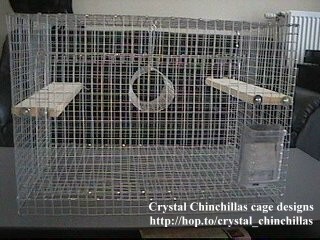
Article written by Anjela Ross of Crystal Chinchillas
Guest writer for
The Chinchilla Club
You can visit Crystal Chinchillas for further information
by using the link below

Which breeding method is
best for me?
Article written by -
Anjela Ross of Crystal Chinchillas
|

Pair breeding is the most common method for breeding
Chinchillas. Youngsters can be introduced to each other before they become sexually mature,
or adults can be introduced relatively easily.( For further information on introducing Chinchillas,
check out http://hop.to/crystal_chinchillas) With introducing youngsters to each other, ie; a male and female both
aged under 7 months, there is always debate. It is possible for the female to become sexually mature under the
age of seven months, allowing her the chance of becoming pregnant before she reaches adulthood. This is a possibility,
but in my opinion, the chance of this occuring is a small one. If the male is also a youngster, then
he may not become sexually mature at the same time, or if he does, being an inexperienced male, he may
not get it right with the female on the first attempt anyhow!
Once the pair are happily
introduced and living together, you will find that they develop a relationship with each other and given time will mate
and the babies will be born. This is the time when another cage is necessary with pair breeding.
I personally do not like to see the male left in the cage when the babies are born, as obviously the female
comes into heat after having littered and then the male has the chance to breed back with her. This
then means that she is not only nursing young, but is already carrying them again. Now and then slip
ups occur and then this happens, but by leaving the male permanently in the cage, he is likely to do the
same thing over and over. This will result in your female becoming weaker and also the quality
and strength of the youngsters she produces deteriorating.
Not all males adapt to fatherhood
well anyhow, sometimes the male will get in the way or perhaps even become aggressive towards the youngsters,
which can result in injuries or death of the babies. You will find that the female is much happier if left
alone with her kits to nurse them in peace without the male around. So the best method, if using pair breeding, is to have
another cage spare, so that when the babies arrive, or preferably a few days before she is due to litter,
if you know her due date, to take the male out. Then to leave him out until the youngsters are weaned
at the age of eight weeks. Then he can be allowed back in with the female. Sometimes, the male will
go back in without a problem. However, if the female decides that it is now her cage, then you will have
to spend a few days going through the process of reintroducing them again.
Pair breeding is relatively simple and useful for those that just have
a few pairs of chinchillas and want to keep it straightforward, with their animals
living happily in couples. |
|
Polygamous ( Tunnel )
Breeding
|

Tunnel breeding is a system that is more commonly used
by hobby breeders or large breeders. This system can be modified to suit everyones requirements.
You can connect together just two cages, or you can adapt it, so that you have
four or more cages all connected by the same tunnel.
The way that is works is as follows. The cage has a tunnel running along
the front at the top, with two entrance holes, often known as popholes allowing
access to each cage. This cage is therefore suitable for, one male and two female Chinchillas.
The male simply shares the females cages for feeding and sleeping, or sometimes he will sleep in
his tunnel. You can also allow an extra cage solely for the male if you so wish and have more than two
cages connected. He can then access each female when she is in heat to mate with her. Only the male can
get into the tunnel. The females are prevented from leaving the cage by use of a collar. The collars are much
like those that you would use for a cat or a dog, except they are either made of toughenened plastic or
light weight aluminium. The collars are made so that they are slightly larger than the pophole, so the
female can stick her nose into the tunnel but may not enter it. This way, if breeding, the benefits are
that you do not have to purchase so many males. You can spend a little extra and purchase an even
better quality male. For that is the idea, to use the best male possible to the females. You can have more babies,
than just having a pair in the same amount of space. Or risking keeping two females together
with one male, which as I will go on to explain, does not always work. Plus if breeding on a larger
scale, that show champion male you have can produce more offspring for you, if he has access to breed with six
good females, giving you better results quicker and also making more sense financially than having to buy six males
to pair breed, let alone finding six show champions to pair breed with! Another benefit from using this system is that on each
pophole there is a shutter, allowing the pophole to be closed should it be required.
For example, if you have four females and one male set up using the polygamous system and one
female litters, you can simply shut the pophole entrance and the male may no longer enter
the cage. He still has the other cages, so he can have company with the other females and also access
to food and water. So this saves the problem of needing extra cages, plus allows the female rest and
peace to nurse her babies without the male troubling her. Also, with him still being able to
run over her in the tunnel, he can still get to greet his youngsters as well as keep in contact with the
female, so she does not have the chance to forget who he is. This then makes it much easier for when the time comes
to wean the babies, they are simply taken away and the pophole is reopened, allowing the male to
enter the cage and get back on familiar terms with his female.
The only problem that can occur, is obviously if you have one male to two
females and they both litter at the same time, you will still need another
cage for him to go into. Unless you have an extra cage added on, that is specifically only for
the male, this way he has his own space, even if his females do both litter around the same time, but
does not mean that he will lose contact with the females whilst they are nursing young as he will
still be able to run over them, by using the tunnel. |
|
In the wild Chinchillas live in Colonies. Colonies
are large social groups. OK, so that is how they do it in the wild, so surely this will work out to
be the best breeding system? In some cases it can work, but on the whole it is not an easy system to maintain
well. In the wild, Chinchillas have plenty of space to roam around and choose how close they wish to live
to their neighbours, as well as choose who they wish to have in the group and dispel those that
they do not. Well, even though the Chinchilla is now a farmed rodent, being threatened in the wild,
it appears that those instincts remain. The only problem is that, one, you cannot give them
as much room as they would have if they were living in the wild and two, they do not get to choose who
they do and do not wish to have living in the colony, that is a choice that you make. So if they do not
get along, there is no way for the Chinchilla who does not fit in to leave the group or to move further apart
from the others to set up its own territory. These, I feel are the main two problems which causes
Colony breeding to be a difficult system.
The best examples I have seen of Colonies with Chinchillas are those made
up of single sex groups, usually female groups. They still all seem
to have a rank, one female that takes the highest position over the others, but the others appear to
accept this and live within this quite well, other than when another female tries to take on the dominant
one, then that is when the fighting begins.
Even if you try to get this system to work on a smaller scale, such as
with two females and one male, it does not always work out. I have
tried this myself and I had a 50 percent success rate. The most common problem, was that the females tend
to adjust when they come into heat to around a similar time to each other. So, if the male then
gets the females pregnant within a week of each other, then the babies arrive around the same time. No problem
for the females, who seem to enjoy grooming and sometimes feeding each others kits, but
for the male, he then becomes an outcast. The females simply do not want him around and he has
to be removed to another cage. Then after the eight weeks when the young are weaned away that is
when the real problems start. The two females then seem to become extremely dominant and make the
cage their territory. Well, sometimes it is difficult enough to get one awkward female in with a male, let
alone trying to get two of them to accept him! I also once encountered a problem of a bossy female,
who insisted that all the babies were her own, even the other females. This ofcourse, was a hard
one to figure out, not only could she not feed all five of them herself, but she would not let the
mother of two of them get anywhere near her own young! In the end, I had to give up and seperate both the
females due to this problem.
It is not always like this, it can work out sometimes and the group live
together quite happily, but at least now you are aware of the problems
that you may encounter along the way. Just one other point to make, the babies will need
to be weaned away from the group. The reason for this being that the adult males, will not discriminate
and will mate with their daughters and the sons, once old enough will also mate with their mothers.
This can also cause rivalry amongst the males when the youngsters get older, as too many males in the
colony does not work out, plus unless you see every mating you do not know who the father is of
the youngsters that are born if you have more than one male in the colony. The closest that you should
ever breed Chinchillas is half brother to half sister. Brother to sister, or son to mother, father to daughter
etc.. should not be allowed. I hope that this article has been of use to you, much
of the information contained within it, is based on my own experiences, throughout the years
breeding Chinchillas. If you have other experiences different to those expressed
by myself, then I would love to hear them, to be able to broaden my knowledge and
to help others. Either way, I wish you every success with your Chinchilla
breeding! |
|
|